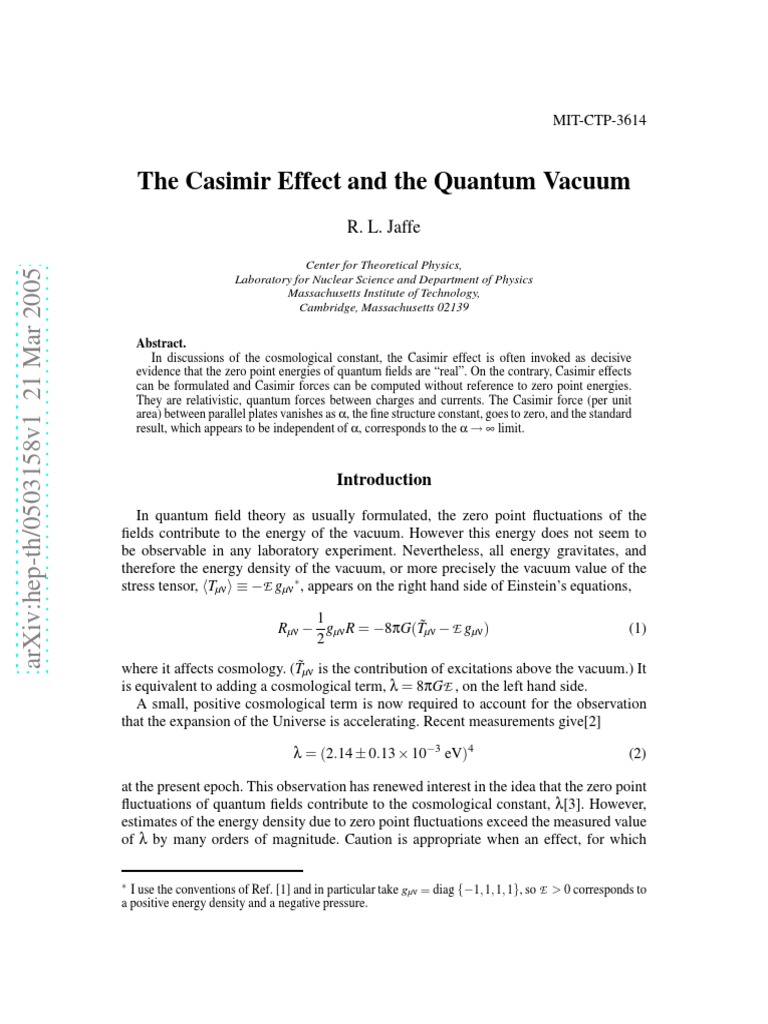The Casimir effect, a quintessential manifestation of quantum field theory, has long captivated physicists and laypersons alike. It speaks not merely to the void, but to the vitality lying dormant within it, revealing an elegant interplay between vacuum fluctuations and the physical world that we inhabit. The term “Casimir Force,” a succinct label for this phenomenon, hints at a mundane attraction, yet it belies a deeper resonance that intertwines the quantum realm with macroscopic life. In this exploration, we shall traverse the landscape of quantum vacuums and elucidate how the presence of forces that arise therein could one day serve fundamental purposes in technological and biological applications.
To initiate our journey through the quantum vacuum, one must first acknowledge the belied richness that lies in the perceived emptiness of space. Conventional wisdom stipulates that a vacuum is an absolute void; however, quantum theory dismantles this notion. Within the vacuum, virtual particles flit in and out of existence—a ceaseless, albeit imperceptible, dance governed by the uncertainty principle. When two uncharged, parallel plates are brought sufficiently close together, these virtual particles exert a pressure differential between the two sides, resulting in an attractive force. This is the essence of the Casimir effect, a testament to the vibrancy of the quantum vacuum. It invites us to reconsider our perceptions of voids and to contemplate their latent potentialities.
Envision the quantum vacuum as a vast ocean teeming with life. In this metaphor, the virtual particles represent the myriad creatures undulating beneath the surface, performing an incessant ballet, even when they are not on display. The Casimir force emerges when two surfaces intrude upon this ocean. The waves generated by their presence inhibit the unrestrained motion of the virtual particles between them, creating a tangible effect in what ought to be a lifeless expanse. Was it not the naturalists of old who sought to define the essence of life itself? Similarly, the Casimir effect delineates the boundary where the inanimate meets the animated.
Significantly, the implications extend beyond mere academic inquiry. Researchers have begun to harness the Casimir force in innovative ways, crafting small-scale devices that leverage this intriguing phenomenon. Micro-electromechanical systems (MEMS) have emerged as one of the promising arenas where the Casimir effect can be exploited. By devising sensors that can detect minute forces at the nanometer scale, it becomes possible to engineer devices that respond to stimuli with unprecedented sensitivity. As such, the Casimir force is not merely a curiosity; it harbors potential that can revolutionize fields like nanotechnology and materials science.
Beyond technological applications, the interplay between the Casimir effect and biological processes cannot be overlooked. The intricate dance of molecular interactions in cellular machinery frequently reflects the principles of quantum mechanics. Consider, for instance, the myriad processes occurring within a cell: proteins folding, signaling pathways activating, and enzymes catalyzing chemical reactions. At their core, these processes are guided by forces that transcend classical descriptions. The notion that the Casimir effect might influence biochemical interactions opens the door to a nascent frontier of research, where quantum physics becomes a litmus for understanding life itself.
Nevertheless, the ramifications extend even further. Theoretical physicists have posited that the manipulation of the Casimir force could lead to novel concepts in propulsion and energy generation. Concepts such as Casimir-driven propulsion systems evoke images of sleek crafts gliding through the void of space, powered not by conventional means, but by the fundamental underpinnings of the universe itself. If one could harness the infinite vacuum energy, the implications regarding efficiency and sustainability become monumental.
Moreover, as we tread deeper into the realm of speculative science, one may envision the Casimir effect as a linchpin in the quest for a unifying theory of quantum gravity. It underscores the possibility that forces at the subatomic level can interact with the very fabric of spacetime. Could the gravity we experience be influenced by these quantum fluctuations? This inquiry resembles a beckoning invitation to rethink the structural underpinnings of reality, as we grapple with questions that inspire both trepidation and excitement.
Indeed, the Casimir effect encourages a dual lens—one that observes both the unexpected beauty inherent in quantum phenomena and the pragmatic implications for our evolving understanding of the cosmos. Every interaction mediated by the Casimir force invites reflection on the continuity of existence, urging us to reconcile microscopic behaviors with macroscopic results. This intersection offers an exhilarating narrative that underscores humanity’s perennial quest for knowledge, intertwining our curiosity about the universe with the lived experience of being alive.
In conclusion, the Casimir effect exemplifies the exquisite tapestry of life, where mere theoretical constructs find a foothold in the tangible reality. It transforms the concept of the quantum vacuum from a mere theoretical abstraction into a catalyst for innovation and understanding. As we continue to explore this frontier, the quantum vacuum ascends beyond emptiness, acquiring a purpose that enriches our scientific endeavors and nourishes our insatiable quest for meaning. Through relentless experimentation and inquiry, the Casimir force may very well inspire a renaissance in how we live, think, and interface with the universe—a testament to the enduring spirit of discovery that infuses human existence.












